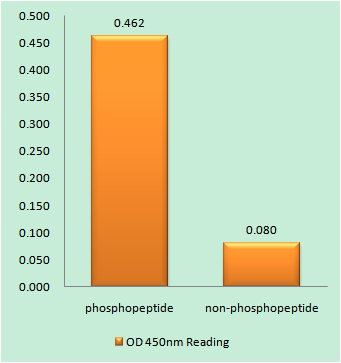Cleaved-Caspase-9 p10 (D330) Cell-Based Colorimetric ELISA Kit
- Catalog No.:KA3926C
- Applications:ELISA
- Reactivity:Human
- Gene Name:
- CASP9
- Protein Name:
- Caspase9
- Human Gene Id:
- 842
- Human Swiss Prot No:
- P55211
- Storage Stability:
- 2-8°C/6 months
- Other Name:
- Caspase-9 (CASP-9) (EC 3.4.22.62) (Apoptotic protease Mch-6) (Apoptotic protease-activating factor 3) (APAF-3) (ICE-like apoptotic protease 6) (ICE-LAP6) [Cleaved into: Caspase-9 subunit p35;Caspase-9 subunit p10]
- Detection Method:
- Colorimetric
- Background:
- catalytic activity:Strict requirement for an Asp residue at position P1 and with a marked preference for His at position P2. It has a preferred cleavage sequence of Leu-Gly-His-Asp-|-Xaa.,function:Involved in the activation cascade of caspases responsible for apoptosis execution. Binding of caspase-9 to Apaf-1 leads to activation of the protease which then cleaves and activates caspase-3. Proteolytically cleaves poly(ADP-ribose) polymerase (PARP).,function:Isoform 2 lacks activity is an dominant-negative inhibitor of caspase-9.,online information:Caspase-9 entry,PTM:Cleavages at Asp-315 by granzyme B and at Asp-330 by caspase-3 generate the two active subunits. Caspase-8 and -10 can also be involved in these processing events.,similarity:Belongs to the peptidase C14A family.,similarity:Contains 1 CARD domain.,subunit:Heterotetramer that consists of two anti-parallel arranged heterodimers, each one formed by a 35 kDa (p35) and a 10 kDa (p10) subunit. Caspase-9 and APAF1 bind to each other via their respective NH2-terminal CED-3 homologous domains in the presence of cytochrome C and ATP. Interacts with the inhibitors BIRC2, BIRC4, BIRC5 and BIRC7.,tissue specificity:Ubiquitous, with highest expression in the heart, moderate expression in liver, skeletal muscle, and pancreas. Low levels in all other tissues.,
- Function:
- proteolysis, apoptosis, activation of caspase activity, response to DNA damage stimulus, cell death, activation of caspase activity by cytochrome c, response to radiation, response to UV, response to light stimulus, response to abiotic stimulus, regulation of cell death, positive regulation of cell death, positive regulation of peptidase activity,programmed cell death, death, cellular response to stress, regulation of apoptosis, positive regulation of apoptosis,regulation of programmed cell death, positive regulation of programmed cell death, positive regulation of catalytic activity, positive regulation of caspase activity, regulation of caspase activity, regulation of neuron apoptosis, positive regulation of neuron apoptosis, positive regulation of molecular function, regulation of hydrolase activity, positive regulation of hydrolase activity, regulation of peptidase activity, regulati
- Expression:
- Ubiquitous, with highest expression in the heart, moderate expression in liver, skeletal muscle, and pancreas. Low levels in all other tissues. Within the heart, specifically expressed in myocytes.
- June 19-2018
- WESTERN IMMUNOBLOTTING PROTOCOL
- June 19-2018
- IMMUNOHISTOCHEMISTRY-PARAFFIN PROTOCOL
- June 19-2018
- IMMUNOFLUORESCENCE PROTOCOL
- September 08-2020
- FLOW-CYTOMEYRT-PROTOCOL
- May 20-2022
- Cell-Based ELISA│解您多样本WB检测之困扰
- July 13-2018
- CELL-BASED-ELISA-PROTOCOL-FOR-ACETYL-PROTEIN
- July 13-2018
- CELL-BASED-ELISA-PROTOCOL-FOR-PHOSPHO-PROTEIN
- July 13-2018
- Antibody-FAQs

